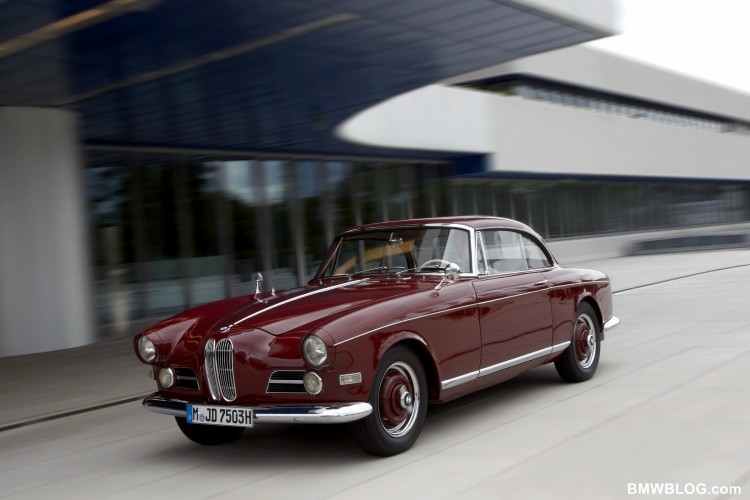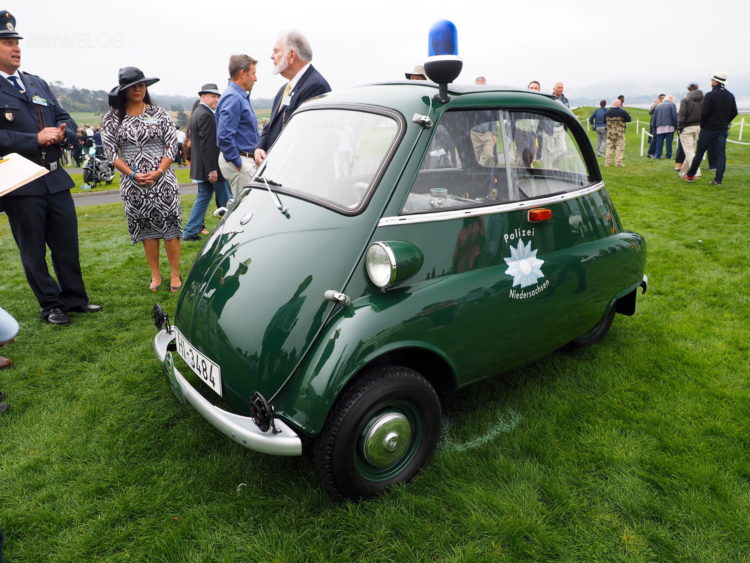The German economic miracle, the ‘Wirtschaftwunder’, was predicated by the western allies currency reform – the replacement of the old Reichsmark with the new Deutschmark, tax reform, and the Marshall Plan. It aided Germany in reordering itself after the war, but there were unintended consequences of the currency reform. It led to the split of Germany into two states, the DDR and BRD – east and west, and eventually the Berlin blockade.
And while Germany attempted to clear away the devastation they had brought on themselves, the shell of what had been BMW was struggling to find a way forward. Franz Popp, who had been with BMW since the beginning, had departed in 1942 and was replaced by Kurt Donath at that time. Donath had come to BMW through Bramo and he would be tasked with leading BMW out of the post-war woods.
While BMW AG existed it was not in an enviable financial position, nor did it have access to the set of facilities it had previously used. The Americans were using the Munich area Allach facility as a repair depot, purportedly paying rent for the facility to BMW. Eisenach was in the hands of the Soviets, who would soon be building ‘BMW’ cars. The Milbertshofen facility was a shadow of its former self and the Americans had yet to allow for the manufacture of vehicles, either motorcycles or cars.

After the war a British aricraft manufacturer, Bristol, obtained the rights – on generous terms – to build an M328 engined automobile, the first of the line, the 401, looking very much like a pre-war BMW328. Bristol would continue to refine the M328 engine and also sell engine and chassis combinations to a Chicago businessman, Stanley H. “Wacky” Arnolt, who built a Arnolt Bristol convertible sports car and coupe in very limited numbers. The Bristol line continued to use their iteration of the M328 through the 406 model designation, of which production ended in 1961.
Another firm, Veritas, made up of former BMW employees, was building formula and sports racing cars using the M238 engine. They built cars from 1945, were reorganized/refinanced in the early 1950s and ran out of money not long afterward. But the cars did well in post war races and some have survived to this day.
BMW was making pots and pans (and other household items) immediately after the war, trying to employ its skilled workforce in any way possible. BMW also explored manufacturing trucks or cars for other firms – anything to keep the labor force busy and to restore the firms capacity to build product.
BMW’s former car factory at Eisenach, inside the Soviet zone of occupation, was taken over by the Soviets. They did manufacture and sell cars, based on pre-war designs, using the BMW brand name, much to the chagrin of BMW. Eventually, after the factory ownership was transferred to the East German state, it was forced to change the name. They chose Eisenach Motorenwerk, EMW, and kept the roundel but swapped the blue for red but they continued to build EMWs based on pre-war BMWs until 1955. The factory was renamed the Automobilwerk Eisenach, AWE, and manufactured a DKW design as the IFA 309. In 1956 automobiles built in Eisenach were branded as Wartburgs.

READ ALSO: BMW History Part 1, 2, 3, 4
Motorcycle production was to return to BMW, after American approval, and a 250cc machine, the R-24 was built. Motorcycle sales would remain strong through the mid-1950s, but as the German economy improved, motorcycles would cease to become a primary means of personal transportation. Even with strong demand for motorcycles, BMW was not making enough of them to provide funding for the development of a car.
Gaining access to funds was difficult, the firm needed to be restructured/reconstituted and the banks would ensure their funds were being used wisely. To that end, Hanns Grewenig was named sales director. Grewenig had significant automotive experience and used that when plans were being drawn up to restart automobile production.

The engineers were working on a pretty little car, which looked not unlike Fiat’s Topolino, that would have adapted an air-cooled 700cc boxer engine, four speed manual transmission, powering a live rear axle. This was known as a Type 531. It would have been an inexpensive car, perfect for the times. But Grewenig knew that BMW would have been unable to sell it in the numbers required to be profitable; the cost of the machine tools to produce it could not be covered. They had neither the funds or facilities to produce it.
Grewenig insisted that BMW concentrate on building a premium vehicle when it reentered the automotive market. And to that end the engineering staff started work on what was to become the 501. Test vehicles were built, one of which was styled by BMW’s Peter Schimanowski, another which was developed by Pinin Farina. In retrospect the Pinin Farina example, based on a design used by Alfa-Romeo, was the cleaner, more modern of the two, but BMW opted for Schimanowski’s design. And thus the “Baroque Angel” was born.
The 501 went on display at the Frankfurt Auto Show in April 1951, it would enter production later. It weighed in at 3100 plus pounds and was powered by an OHV 2.0L six cylinder producing 65 HP, so it wasn’t exactly sprightly taking just under 30 seconds to reach 62 MPH. It used a ZF 4 speed gearbox with synchromesh in all forward gears. Something would have to be done about performance.
The solution was found in the form of an aluminum V8. BMW had studied a couple of US-made V8s, an Oldsmobile and DeSoto (Chrysler Hemi) and found that the Oldsmobile was the better of the two. The problem with the US V8s was their cast iron construction. BMW did not want to increase the weight of 501 (heavy to begin with) and particularly on the nose of the car. So the all aluminum construction of the 500 series V8 engines was specified. The cylinder liners were ferrous of course, but the short block and heads were aluminum. The result was an increase in displacement and power without a subsequent increase in weight. And BMW ended up with an engine that could be optimized for other installations.
Those other installations included a pretty coupe and convertible 503 which featured a slimmed down but still upright kidney grille, and the stunning, Albrecht Goertz styled, BMW 507 – which featured a more horizontal interpretation of the kidney grille. The 507 was intended to be sold in the United States; the were to be imported by Max Hoffman – a dealer/importer of European marques, whose relationship with BMW would be tested in the near future. The 507 was definitely a design of its time – see the earlier Ferrari 500 Mondial for example. (Goetz would later go on to design the Datsun 240Z and one would be remiss not to mention the Ferrari 275 GTB as a starting point.) Regardless, neither the Baroque Angel, the 503, or the 507 could be produced in the numbers required to fund expansion. They needed something that would appeal to the masses.
And that car came along in the form of the BMW Isetta 250 and 300. The Isetta was an Italian design from the Iso company – a manufacturer of refrigerators, that also later built cars with the owner’s name appended, Iso Rivolta – that was licensed by BMW (and several other manufacturers). The BMW Isetta came at a propitious time – the Suez crisis was about to roil the oil markets. And, to add impetus to sales, motorcycles were being discarded as a primary means of transportation by increasingly better off post-war families. The two place, single cylinder, BMW 250 and 300 were built in 3 and 4 wheels variants (which variant was available depended on the market’s tax situation). The public referred to them as ‘das rollende Ei’, literally ‘the rolling egg’, BMW’s advertising firm declared them, motocoupes. Whatever they were called they were small, slow, and basic. But they did provide an income stream.

BMW expanded the line to include a four place, two cylinder model, the 600. But sales of the 600 never really took off and when the reasons for slow sales were examined it was found that the styling was not ‘right’. And then the impact of the Suez crisis faded and interest in ‘bubble cars’ faded with it. BMW had prepared a nifty stylish follow on to the 600 in the 700, first as a two place sportster and then a four place car.
German firms were prohibited from building jet engines until 1955, and while BMW was not in a financial position to take advantage of its experience in building the 003, they still wanted to explore the market. Without a partner it would be difficult, and while they did explore building small turbine engines, for stationary use, they had lost a lot of equipment and personnel after the war. While not a dead end it certainly wasn’t the road to profitability and subsequently stability.
While BMW was hanging on by a thread, two German auto companies were thriving. VW, shepherded to health by British occupation officers, was having success in export markets. And Daimler Benz was firing on all cylinders and, in 1958, bought 87% of the surviving Auto Union concern which was selling DKWs. Daimler Benz purchased the remainder of Auto Union in 1959 and was in the hunt for more companies to gobble up. With BMW struggling, approaches were made to Daimler Benz and, in 1959, a takeover of a majority of BMW shares had been hammered out. It was all over for BMW except for the shouting and a stockholders meeting, where approval of the sale would be sought before it could take effect.








































































